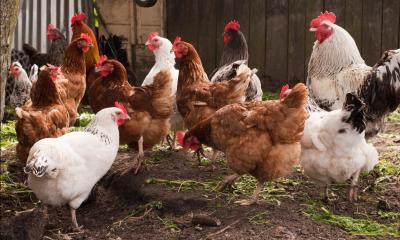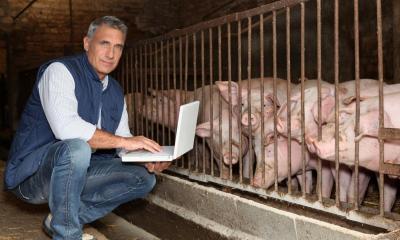
If you're planning on running a poultry farm you'll need to decide whether you'll focus on egg production or on producing birds for the table. Our practical guide will help you start up and run your poultry business.
- Establish your target market
- Type of business
- Yields and mortality levels
- Pricing policy
- Estimating sales
- Buy an existing business
Establish your target market
Market challenges
Some UK farming sectors are experiencing a crisis. Farmers are facing a range of challenges including staffing shortages, rising costs – particularly energy and feed – and the ongoing threat of Avian Flu which has required keepers of both captive and poultry flocks to house their birds and implement strict bio-controls.
Estimating demand
You will need to make an estimate of the type and number of customers who might buy your products.
The vast majority of the table birds that are sold in supermarkets are produced by a handful of very large producers whose economies of scale and tightly controlled processes allow them to supply birds that can be sold at the retail level at very competitive prices. Outside of these large organisations there are smaller producers that target more niche markets, such as organic.
Similarly, intensive egg producers that house their birds in enriched cages operate on fairly slim profit margins.
Depending on how your own business operates, you may have a mix of trade and retail sales.
Trade sales
It is likely that a large proportion of your sales will be trade sales. Depending on how your business is going to operate, your trade customers may include:
- supermarkets and other large retailers
- egg packing stations
- processors
- wholesalers
- local retailers
- local restaurants and hotels
- other poultry enterprises (sales of chicks from a breeding enterprise)
Try to find out whether you will find a market for your produce among these customers and whether the price they're prepared to pay will leave you enough profit. To do this you could:
- Contact egg packing stations, supermarkets, wholesalers and processors to find out what price they will pay you for your eggs and/or poultry meat and what entering into a contract to supply them would entail. You can get average packer-to-producer and other farmgate prices from Defra statistical publications on the GOV.UK website. There's also helpful gross margin information available in publications like the John Nix 'Farm Management Pocketbook'
- Make a list of local retailers and catering establishments that you think may take your produce and approach them to see if they would be interested. Don't forget that if they are already being supplied you will have to give them a good reason to change. This might be better quality, lower prices, more regular deliveries or a better service.
- Contact other poultry enterprises and find out if they would be interested in having you supply them with chicks, if you plan to start a breeding enterprise
Selling to the public
If you plan to sell produce direct to members of the public at the 'farm gate' or in other ways, try to make a realistic estimate of the number of people that will buy from you in this way. Factors that may increase the number of people that will buy direct from you are:
- If there is holiday accommodation such as a camping or caravan site nearby. Holiday makers are often keen to buy fresh produce - and you may find that they are prepared to pay higher prices.
- If your local area is not well served with shops.
- If there is something that differentiates your produce from that of your competitors. For example, you may be the only organic poultry farmer in your area.
- If you take a regular stall at one or more farmers' markets.
- Where there is a demand for a home-delivery service. There was an increase in demand for these types of services thanks to the COVID-19 pandemic.
It is likely that farm gate sales will not represent a particularly large percentage of your overall sales.
Find out what people want
If you are planning to sell a large proportion of your produce through local retailers and catering outlets, you could consider carrying out a survey of those businesses to identify the sector of the market that you should aim for. You may find from talking to prospective customers that, for example, there is unmet demand for organic and free-range eggs and poultry meat in your area. Taking the time to do this type of research may ensure that you have a market for your produce when you start your enterprise.
Research current trends, plus legal and tax issues
Type of business
There are several different types of poultry enterprise and you may be planning to operate as one or more of the following:
- Breeding and hatching chicks to supply to other poultry units. To do this you will keep a breeding flock, generally housed in a temperature-controlled environment with slatted or deep litter floors. The ratio of female to male birds is usually around 13:1. The hens lay in nesting boxes; the eggs are then placed in incubators for 18 days. They are then transferred to hatcher cabinets for three days and hatch on day 21. The chicks are usually sold at one day old.
- Pullet rearing to supply 17-week-old birds to laying flocks. Pullets are generally reared from chicks bought in from a specialist breeder (mentioned above) and then reared in a controlled environment until they reach 17 weeks.
- Keep a laying flock for the production of eggs for human consumption. Pullets are bought in as 17-week-olds and can start laying at around 18 weeks. The peak laying period is the first 13-15 weeks after they begin to lay and then their production starts to tail off. A flock generally lays for 52 weeks and then all of the birds are culled, usually when they are between 72 and 77 weeks old. There are different methods of egg production, such as intensive, free-range, organic, barn and perchery.
- Broiler production. This is the production of birds for table consumption. Day-old chicks are generally bought in from a specialist and are fattened in a controlled environment. In intensive units, the birds are fattened until they are 46 days old and in free range units until they are 56 days old. Organic units using fast-growing strains of birds must keep them until they are 81 days old; units using slow-growing strains must be kept for at least 70 days. (Faster-growing breeds must be kept for at least 81 days to discourage their usage.)
Yields and mortality levels
It is important when making financial forecasts for a poultry enterprise to make an informed estimate as to what the yields of the various aspects of the venture will be as well as making an allowance for the death of a certain percentage of your birds. You may find the following figures useful when making your estimates:
Yields
- 'enriched' intensive egg production - 310 eggs per bird per year
- free range egg production - 300 eggs per bird per year
- barn/perchery egg production - similar to free range
- chick production - of the 240 or so eggs laid in a year by each member of the breeding flock, you could expect 80%-85% to be suitable for hatching
Mortality
- intensive egg production - 5%
- free range egg production - 5%
- barn/perchery egg production - similar to free range
- pullet rearing - 3%
- broiler production - 5%
Source of figures: The Farm Management Pocketbook (various editions), John Nix
Note that although these figures are a useful starting point, they are included for illustration purposes only. Your results may well be significantly different, particularly if you lack experience.
Avian influenza (Bird Flu) also presents a risk to flocks and keepers have periodically been ordered to keep their birds housed. Bird flu is a notifiable animal disease. If you suspect any type of avian influenza in poultry or captive birds you must report it immediately by calling the Defra Rural Services Helpline on 03000 200 301.
Pricing policy
Farm gate prices for free-range eggs have surged in recent years. Some typical prices that you could expect to receive for the sale of your products are shown below:
- 'enriched' intensively produced eggs, average price from a packer - 72 pence/dozen
- free range eggs, average price from a packer - 102 pence/dozen
- perchery and other eggs, average price from a packer - 96 pence per dozen
Figures are based on DEFRA averages and are included for illustrative purposes only. Because prices in the farming sector can change significantly, it is recommended that you get up-to-date price information from the DEFRA section of the GOV.UK website. There's also helpful pricing information available in publications like the John Nix 'Farm Management Pocketbook'.
The price of eggs shown is how much a specialist packer would be likely to pay. If you sell to a packer, the packer will collect the eggs, grade and box them so the price you receive reflects that. If you sell to retailers, you will have to grade and box the eggs yourself but are likely to receive almost double the price per dozen. Similarly, if you sell direct to the consumer then you could expect to realise about three times the packers' price.
Organic producers can expect a significant price premium over free-range producers for both their eggs and poultry meat, as long as there's an established market for their produce.
Estimating sales
The two major factors that will influence your total sales income are the quantity of produce that you sell and the price that you receive for it. The price that you receive will be influenced by who you sell to and by the nature of your business (for example, organic and free range farms are likely to achieve higher prices than an intensive unit). The quantity that you produce may be limited by the physical size of your farm (and by the laws covering stocking densities), the efficiency of your farming methods, the number of employees you have and the amount of capital that you have available to invest in your flock.
You also need to take into account:
- your own experience (or lack of it)
- unexpected levels of mortality amongst your birds
- lower than anticipated egg yields and broiler growth rates
Buy an existing business
You might decide to buy an existing poultry farm rather than start your own venture from scratch. Buying a going concern can mean that the products, customers, regular sales, staff, premises and equipment are already in place.
Other matters to consider include:
- the age, health and condition of the flock - for example, you'll want to check that laying hens aren't coming to the end of their useful life
- if it's an intensive broiler or egg unit, whether the cages meet current regulations. If they don't - and if you intend to continue with intensive production - you're likely to have to replace them all, which can be very costly. (If the unit is currently in operation then it's almost certain that the cages will be compliant but if it has been standing empty since the most recent legislation change at the start of 2012 then there's a chance that they won't be)
But buying a business can be a hazardous, expensive process unless you have the right skills and experience on your team, including legal and financial know-how. Establish the genuine trading and financial position, so that the price you pay for the business is not too high.



